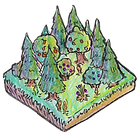Agroforestry
Agroforestry is the practice of integrating trees into agricultural land. And it is true — trees alone do not make a forest. Yet even single trees, and especially those planted in guilds or organized rows, can profoundly improve the microclimate, enhance water and nutrient cycles, and expand habitat and food sources for countless organisms. In doing so, they foster biodiversity — and with it, the natural resilience of ecosystems to pests, diseases, and climate stress.
Tree guilds or rows are not yet a forest, with its complex and only partly understood web of relationships among all living and non-living elements. Yet they are much more than a sown grassland or a monocultural crop field. Agroforestry is a step toward making agriculture more nature-aligned — a system that cooperates with, rather than competes against, ecological processes.
In this booklet "Agroforestry in Practice: Demonstration Farms from Latvia and Sweden" we share diverse experiences of farmers who have begun this journey — transforming ploughed fields into living landscapes and moving, step by step, toward their own versions of the Garden of Eden.

Väversunda berry orchard
Väversunda berry orchard is a commercial farm cultivating strawberries, rhubarb, and cherries, which started as a post-retirement project south of Vadstena. The site includes an 8-hectare "emergency forest garden" established in 1996, focusing on resilience through established nut trees and diverse native and fruit/nut species

Östergård farm
Östergård farm is a forest grazing system located in southern Småland where Anders Rydén manages his production forest using Belted Galloway cattle to suppress undergrowth. This method facilitates the transition from spruce monoculture to a more robust deciduous forest while increasing biodiversity and reducing the need for costly clearing

Rydeholm farm & forest garden
Rydeholm farm & forest garden is a 14-hectare extensive food forest and agroforestry demonstration site in southern Sweden, focusing primarily on nut trees. The long-term vision is to replace annual monoculture crops with tree crops, such as sweet chestnuts and walnuts, to achieve sustainable agriculture and biodiversity goals




Boat in Forest farm
Boat in Forest farm is a homestead focused on reconnection processes, featuring food forests, nut cultivation, and bio-pools across approximately 4 hectares. They plant a large genetic diversity of walnuts, sweet chestnuts, hazelnuts, and pine trees to ensure resilience and resistance to disease in a mild coastal climate


Österlen’s arboretum
Österlen’s arboretum is a 4-hectare public recreation spot located by the Baltic Sea, managed by a non-profit association. The site functions as a learning site and seed source, currently experimenting with planting grafted and seeded walnut varieties, often utilizing the niches left by ash trees killed by blight


Ēdenes Dārzs
Gramzdas Ēdenes dārzs is established as a multi-layered food forest garden in South Kurzeme, based on permaculture principles, intended for long-term yields and farm self-sufficiency. This garden features an extensive collection of over 125 edible plant species, integrating exotic plants like pawpaw (asimina) and persimmon to test their hardiness, while windbreaks are planned for protection against strong winds


Rūķmuiža
Rūķmuiža, Vadakste Biodiversity Forest is a 50-hectare site in southwestern Latvia aiming to restore deciduous forest character while assisting the migration of new vegetation, including nut trees, for food and timber. The farm utilizes a random, multivaried system planting nut and fruit trees within existing thinned pioneer alder stands, alongside sparsely spread alley cropping trials

I'm a Tree
"I'm a Tree, what do I need?" is a film portraying the Latvian forest owner and forester Agnis Graudulis, who for several years collected seeds of sweet chestnut (Castanea sativa), walnut (Juglans regia) and much more in Nordic and Baltic countries, with the aim to get as broad genetic diversity as possible, and has since built a 50 hectare Food forest system (Vadakste Biodiversity Forest) with great dedication of labor to the plantings, nature-based solutions to water management and biodiversity. Runningtime 20 min. Photography, editing, production: Maja Lindström Kling.

Ragares Herb farm
Ragares Herb farm, located in Skrīveri, cultivates about 100 edible fruits, berries, and medicinal herbs across 7.5 hectares using permaculture principles. The farm designs its specialized tea recipes based on natural and folk medicine, while the structural diversity of plants creates a favorable microclimate and a self-regulating ecosystem


Bekas
Bekas is a family farm, demonstration site, and learning centre dedicated to grassland restoration in northern Latvia, which is partly located within the Ziemeļgauja nature reserve, one of the country’s most species-rich Natura 2000 areas. Utilizing "biodiversity farming" methods, including the grazing of about 60 Scottish Highland cattle, removal of trees and bushes, and mowing of varied intensity, the farm successfully restores overgrown oak meadows, improving the vegetation composition toward biologically highly valuable grassland.

Gundegas
Gundegas, NATURE GIFT cranberry farm is a commercial cranberry operation established on a pristine peat bog north of Riga, utilizing an alley-shaped cultivation system. Pine and birch trees planted in the alleys mitigate spring frosts and contribute to cooler surface temperatures, which is crucial for the development of the cranberries' flavor and color.


Pardenči
Pardenči, SKRĪVERI FORESTRY DEMONSTRATION TRIAL was established in 2011 to test introduced, fast-growing, short-rotation tree species and perennials suitable for industrial biomass production on agricultural land. The trial features tree species like maple, linden, and alder planted in rows alongside energy crops such as Reed canary grass, aiming for high industrial yield


Līči
Līči, selfsufficient historical homestad, is 17-hectare farm that began agroforestry practices (in the form of a food forest garden) in 2020, concentrating on securing the family's "food bank" and maintaining a biologically oriented lifestyle. The system incorporates intentionally created windbreaks using hazels, rowans, and sweet cherries to improve the microclimate and soil health through mulching, while large, conserved oak trees protect and adorn the site


















